Surely Candid Camera host Allen Funt couldn't have predicted that hidden cameras would become so ubiquitous in our lives, but here we are, surrounded by Closed Circuit TV (CCTV) cameras nearly everywhere we go, our every movement being surreptitiously recorded. Some find solace and security in this near-constant surveillance; others worry that cameras everywhere are a civil rights violation that has the ability to affect our free expression. One thing is undeniable: You're being watched.
Dumb and dumber
The black-and-white CCTV video opens on a nearly empty parking lot off of Aerovista Place near the airport. You can see car headlights driving along nearby Broad Street. The young trees in the parking lot medians sway slightly in the breeze. Out of the left side of a frame, a bare-chested man walks through the lot trailed by a young woman, both disappearing from the bottom right corner of the frame.
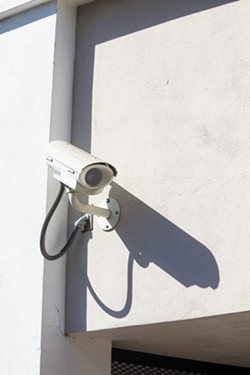
- Photo By Jayson Mellom
- CHECK YOURSELF Security camera footage from local businesses that capture criminal activities is regularly turned in to the SLO Police Department, which often posts it on Facebook, hoping the public can identify the perpetrators.
A minute later, both figures re-enter the frame, she's trying to stop him, and he's trying to get around her. They disappear again, and then the man, now wearing a white T-shirt, comes charging back into the frame, runs toward a parked BMW, leaps onto the trunk lid, and smashes the rear window before falling off the car and appearing to knock himself unconscious as the woman runs up to him.
She walks around him, nudging him with her foot, maybe calling his name though there's no sound, and he seems to move slightly but it's hard to tell in the footage. Finally, she reaches down and appears to push him a little to rouse him. She grabs his arm and tries to pull him up but he just lays there. She continues to stand there, and then he moves, sits up, but appears dazed.
She starts to walk away, stops, turns around. He finally gets up, steadies himself on the smashed car, and she returns to him. Then they appear to be arguing. They pivot around each other, clearly agitated, then she walks away and he goes in the opposite direction, shaking his arms over his head like an agitated silverback gorilla as he moves toward one of the little trees that was earlier swaying in the breeze, which he grabs by the trunk and shakes violently, apparently trying to uproot the sapling.
Patrick Scudder of Quaglino Properties noted that the area has seen a lot more late night activity since the SLO Brew Rock Event Center opened, so the couple were most likely attending a concert that night. The footage shows both the capabilities and limitations of CCTV. Yes, it can capture an apparently drunk fool and his exasperated girlfriend vandalizing a parked car and tree, but neither could be identified from the footage alone.
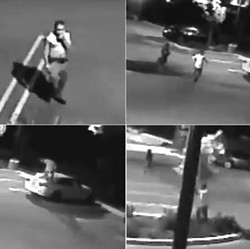
- Images Courtesy Of Quaglino Properties
- PUNK IN DRUBLIC A vandalism suspect can be seen entering a business parking lot, arguing with his female companion, smashing the window of a BMW, and trying to uproot a small tree.
"We own and manage about 25 commercial properties in and around SLO, and we have security cameras set up at about six of them," Matthew Quaglino of Quaglino Properties explained via email. "Some of the video we catch is either hilarious or just maddening. We've had people go into the entry foyer of a downtown building and use the entry as a bathroom, among other things. Last year we caught the graffiti artist called SOAP. He was a prolific tagger all over town, and the police department was able to identify him and prosecute him. He's no longer tagging our city.
"The problem is [that] having the video is a long way from catching whomever they are," Quaglino continued. "In addition to our cameras, there are many more properties downtown that are catching lots of the same. We always turn these tapes over to the police, but they're usually not a priority for them."
Of course, sometimes business cameras are exactly the evidence needed to prosecute a crime. A 2016 video recorded at Mr. Rick's in Avila Beach captured former SLO city building inspector Christopher Matthew Olcott's unprovoked assault on two other patrons, Camille Chavez and Issac McCormick. Though the public was outraged by the three years it took to prosecute the case and deliver a light sentence of 60 days in jail and three years of unsupervised probation, the security camera video was instrumental in bringing Olcott to justice.
Here, there, everywhere
According to SLOPD Capt. Brian Amoroso, "We first installed cameras approximately five years ago. Their purpose was to provide a way to capture evidentiary video in areas where crime was occurring, and to potentially act as a deterrent."
The SLOPD currently maintains 14 Police Observation Devices (PODs), most of which are located in downtown SLO. It's unclear whether they're much of a deterrent, as many of them are difficult to spot unless you're looking.
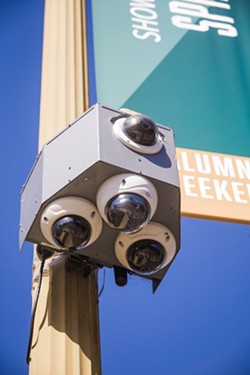
- Photo By Jayson Mellom
- BIG BROTHER The SLOPD operates 14 of these $8,500 Police Observational Devices (PODs), which are located in high-crime areas of the city, sometimes changing location when needed.
"Several are in parks, and some of them move around in response to problem areas," Amoroso noted. "Each POD is a self-contained unit that has four cameras, and they can readily be moved to different locations."
If you're imagining a room full of police officers gazing at monitors, ready to dispatch a car to the next drug deal or purse snatching, guess again.
"They're not monitored," Amoroso said. "They're used to pull video when reports of crime have occurred. We've used them for live monitoring in the past on occasions such as the Women's March. We do sometimes have cameras in the neighborhoods surrounding Cal Poly depending on the time of year or in response to an increase in crime trends in that area."
Each POD costs about $8,500, and the SLOPD handles the installation and maintenance in-house. Depending on the unit, the recorded video is overwritten every 30 to 60 days. The newer PODs have more storage space.
"If we download video for a case, it's retained for as long as necessary until the case is adjudicated," Amoroso explained. "After the case is over, it will be purged per normal departmental retention policy. There is no cost for the storage of video."
Existing city servers store the video that's been downloaded and booked as evidence, and Amoroso said, "There are very clear state laws and department policy and procedure that governs how police employees manage evidence and confidential information. Any surveillance footage obtained from cameras fall within that same structure," meaning some checks and balances exist to ensure video evidence is properly managed.
When the SLOPD use video footage from sources other than their own cameras, they need a warrant to "obtain" but not "to use" the footage. For instance, in the case of the Quaglino footage capturing the BMW vandalism, since the footage was freely given, no warrant was necessary. But if "they did not want to give us video, then most likely yes," Amoroso said, a warrant would be required to obtain it legally.
So just how often do these PODs catch criminals? Apparently not that often. Amoroso had to go back to July of 2017 when three "Hispanic males" were filmed assaulting another man.
"One that comes to mind is a stabbing that occurred in Bubblegum Alley," Amoroso recalled. "Although the identity of the suspect was known, the video was helpful in showing exactly what happened versus relying on statements or recollection of involved parties that may or may not have been intoxicated."
That raises the question of whether or not $119,000 of these PODs is worth it. Has the city conducted any studies on their cost-effectiveness?
"Not that I am aware of," Amoroso admitted. "It's difficult to capture crime deterrence statistically."
Knock, knock! Who's there?
Do you have a Video Doorbell by Ring? An Arlo system? Something installed by one of the many local security companies such as Sentinel Security Solutions, Integrity Systems, or SecurePRO? You're not alone. Estimates of U.S. homes with security cameras range from 17 to 27 percent, and if you want to see some of your neighbors' footage, head over to the SLO Police Department's Facebook page, where they regularly post crime footage with the hope that the public can help identify suspects.
From package stealers on front porches to bike thieves at Laguna Middle School to shoplifters at businesses like SLO Camp N' Pack, the SLOPD posts it all.
"Our Facebook page is filled with examples of posts we make looking for a citizen to recognize a suspect," Amoroso said. "We've had large success in identifying suspects by utilizing video from doorbell and home cameras."
Of course, having footage is no guarantee of success.
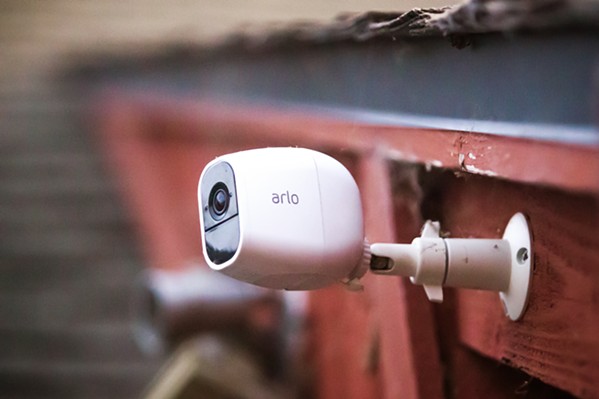
- Photo By Jayson Mellom
- HOME SECURITY Estimates suggest that between 17 and 27 percent of U.S. homes have security systems, like this relatively inexpensive Arlo camera, that can be accessed by smartphone.
"It just depends on the position of the camera, lighting, time of day, and so on," Amoroso added. "Sometimes our officers see someone they recognize; other times the public aids us in identifying the suspect. In some circumstances, we are unable to identify the suspect."
All these cameras might give the public a false sense of security. New Times received a story request from a woman whose bike was stolen. When she went to her landlord to request the surveillance footage from her complex's security camera system, her landlord informed her the system was broken.
Are those recording?
Drive around San Luis Obispo and when you get to a major intersection with a traffic light, glance at the signal or light poles nearby and you're likely to see hooded cameras pointing down at the converging streets. Are they there to catch red light runners? Nope. According to Deputy Public Works Director Jake Hudson, those are signal cameras used by the Public Works Department Signal Crew to manage traffic lights.
"The police department does not have access to those cameras," Hudson explained. "The city started shifting from magnetic vehicle detection to image—or video—detection in the early 2000s. They're all operational. The camera and its other components tell the signal's computer if there are cars and where, and the signal then adjusts the timing based on where there is vehicle demand."
There are 86 traffic signals around San Luis Obispo, and "the ones that do use video detection typically have four cameras at each location," Hudson noted. "The cameras are generally not monitored or recorded. They just tell the signal computer if a vehicle is there or not. On rare occasions, city staff may view the video feed to troubleshoot signal malfunctions or count cars."

- Photo By Jayson Mellom
- NOT INTERESTED IN YOU These traffic signal cameras located at major intersections communicate with a computer to adjust traffic light changes depending on traffic flow. They don't record and can't help exonerate you in a car accident.
Hudson said people have asked to review footage if they were in an accident, for instance, and hoped that the video might show who was at fault, but "because we don't record we were never able to provide it."
He also notes that SLO, unlike some cities, doesn't use license plate readers to record red light runners, though the city has a few in parking garages to keep track of overtime violations or for car structure occupancy studies.
Some gated communities or neighborhoods with home owners associations also use license plate readers in something called "Flock Safety" systems, which record license plates of cars and comings and goings through neighborhoods.
Amoroso said he wasn't aware of any Flock Safety systems in San Luis Obispo.
"However, if they were installed on their own property, I believe they would be legal. There's nothing illegal about recording license plates as they drive by," he said. "They're in public and clearly visible."
Does legal equal right?
According to its website, the American Civil Liberties Union (ACLU) has four major problems with public video surveillance. It argues that video surveillance hasn't been proven effective: "The implicit justification for the recent push to increase video surveillance is the threat of terrorist attacks. But suicide attackers are clearly not deterred by video cameras—and may even be attracted to the television coverage cameras can ensure. The real reason cameras are usually deployed is to reduce much pettier crimes. But it has not even been demonstrated that they can do that."
The ACLU cites a British study that said cameras did not cut crime or a fear of crime. It also argues that CCTV is susceptible to abuse, noting that a "top-ranking police official in Washington, D.C., was caught using police databases to gather information on patrons of a gay nightclub." The ACLU cited another study that showed, "Black people were between one-and-one-half and two-and-one-half times more likely to be surveilled than one would expect from their presence in the population."
The technology has advanced more quickly than appropriate checks and balances, the ACLU also argues. Systems put in place for one stated purpose sometimes are used for others, and as cameras continue to gain abilities such as "see-through vision" or are augmented with artificial intelligence, more abuse is possible.
Finally, the ACLU argues that surveillance "will have a chilling effect on public life," potentially changing the way we behave and dress, even if that behavior and dress is legal and protected under the First Amendment.
Despite the ACLU's objections, there's little hope of reversing the ever-growing surveillance state. In fact, if the current trend continues, you can expect more cameras in your future.
"I have not seen the ACLU comments," Capt. Amoroso said. "Surveillance cameras in public areas are simply capturing areas that do not constitute an expectation of privacy in public." Δ
Contact Senior Staff Writer Glen Starkey at [email protected].
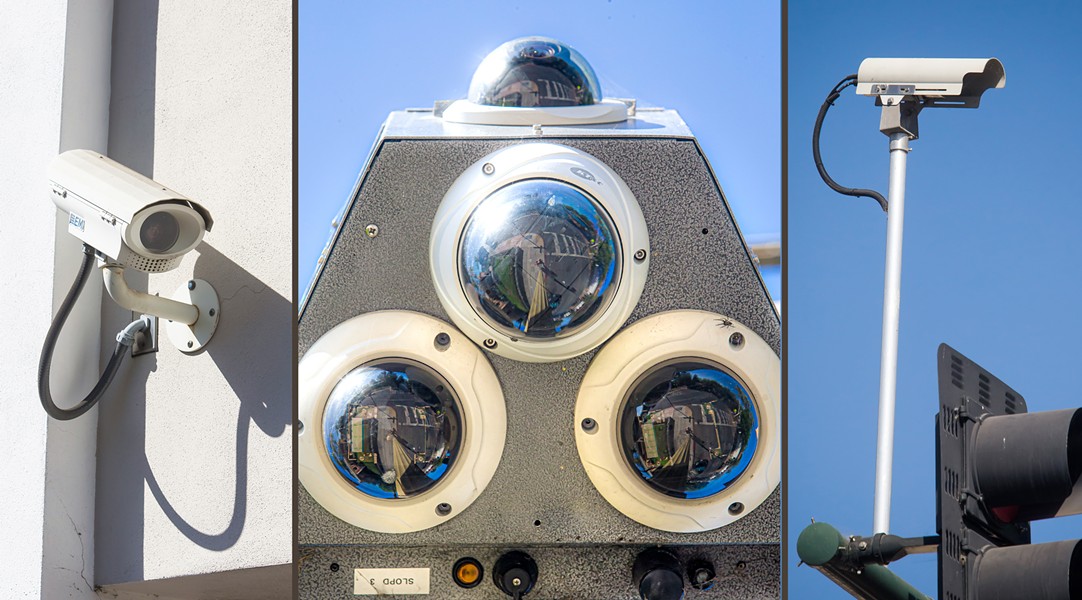


Comments
Showing 1-1 of 1